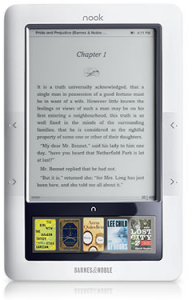
My wife has been reading books on her palm pilot for years but when the prices began to fall on the e-ink e-readers recently I urged her to get one of those instead. The e-ink screens aren't backlit, so you have to read them in a lit room or outside but they're reflective (like real paper) so they're much easier on the eyes than what is, on LCD screens, essentially staring into a glowing lamp. We looked at the Amazon Kindle, the Sony e-reader and the B&N Nook. I'm a long time Amazon customer, so it seemed natural that we'd go for the Kindle, but the Kindle doesn't support the electronic book formats that our library uses and I'm not a fan of vendor lock in like that. Also, we were afraid that we'd end up spending a lot of money for Amazon content that we weren't planning to do because it would be so easy. Sony was out because I'm a rabid anti-Sony person - I won't buy anything made by that company for multiple reasons no matter how great it might be - don't get me started. The Nook runs Android, supports our library's file format (ePub, an open but DRM-able format), costs less. While I don't like the idea of the separate touch screen, at least it doesn't have a bunch of stupid blackberry-like buttons on it, so we decided on the Nook - here's some quick first impressions:
There are two models of the Nook, one with 3G and one without. We both discussed whether we really needed a 3G connection and reasoned that having 3G would make it too easy to buy things on a whim, and that most of the time it would be used, wifi would be available anyway if needed. Opting for the wifi only version got us a Nook for only $149. The local Barnes and Noble didn't keep these models in stock so we had to order it.
She received her new Nook yesterday and got it connected to our wifi (an Apple Airport snow) without issue. She was also able to transfer ePubs from the library to it from her computer easily since the Nook appears as an external drive when plugged in via USB. The Nook is a nice size, and comfortable to hold in the hand, though I've read its heavier than the Kindle. There are a couple buttons on the left and right side which can be used to turn pages, but the main way you operate the device is via a color LCD touchscreen at the bottom. My wife prefers to use a finger gesture (a downward swipe) on the touchscreen (which remains unlit yet accepts the input) to change pages instead of the buttons. My first impression of the separate screen wasn't good. The e-ink screen isn't backlit, so you need some kind of light to see it - but even sitting near a lamp the smaller LCD input screen was so bright it draws your attention and then blinds you. It might just be the contrast of the grey and easy to read e-ink screen with the brightness of a typical color LCD screen, but its distracting and I can imagine it sucking the battery dry fairly quickly. I don't know if there is a way to reduce the brightness of the 2nd display or not yet.
My wife had the wifi disabled (set to airplane mode) to save battery life, so I enabled it to test the web browser (which is marked as in beta). The menu selection interface of the LCD screen was well thought out and fairly intuitive - I was able to turn on the wireless and launch the browser in seconds. Personally I don't read novels. I do read history but most of the things I'm interested in are pretty obscure and not generally available electronically or are out of print. The only thing I'd want to use an e-reader for is reading articles posted on websites and trying to do this on the Nook was disappointing. Since the e-ink screen on the Nook isn't a touchscreen, you can't use your finger to select links directly or scroll, you have to do your input on the smaller LCD screen. This means that for browsing for something of interest, you'll end up having to look at the bright input screen a lot. The e-ink screen can only display about half of a normal sized webpage, and the LCD screen can only show a tiny portion of that, leaving you navigating around in about 20% of the page (and not doing so directly, but by proxy on the LCD screen). I realized then that my perfect e-reader will have a touch screen e-ink display and a web-browser.
I looked at an example ePub and it was displayed very nicely on the e-ink screen, very readable - so if you're content with loading novels (which is what my wife intends to do) then the device should serve the purpose well.


